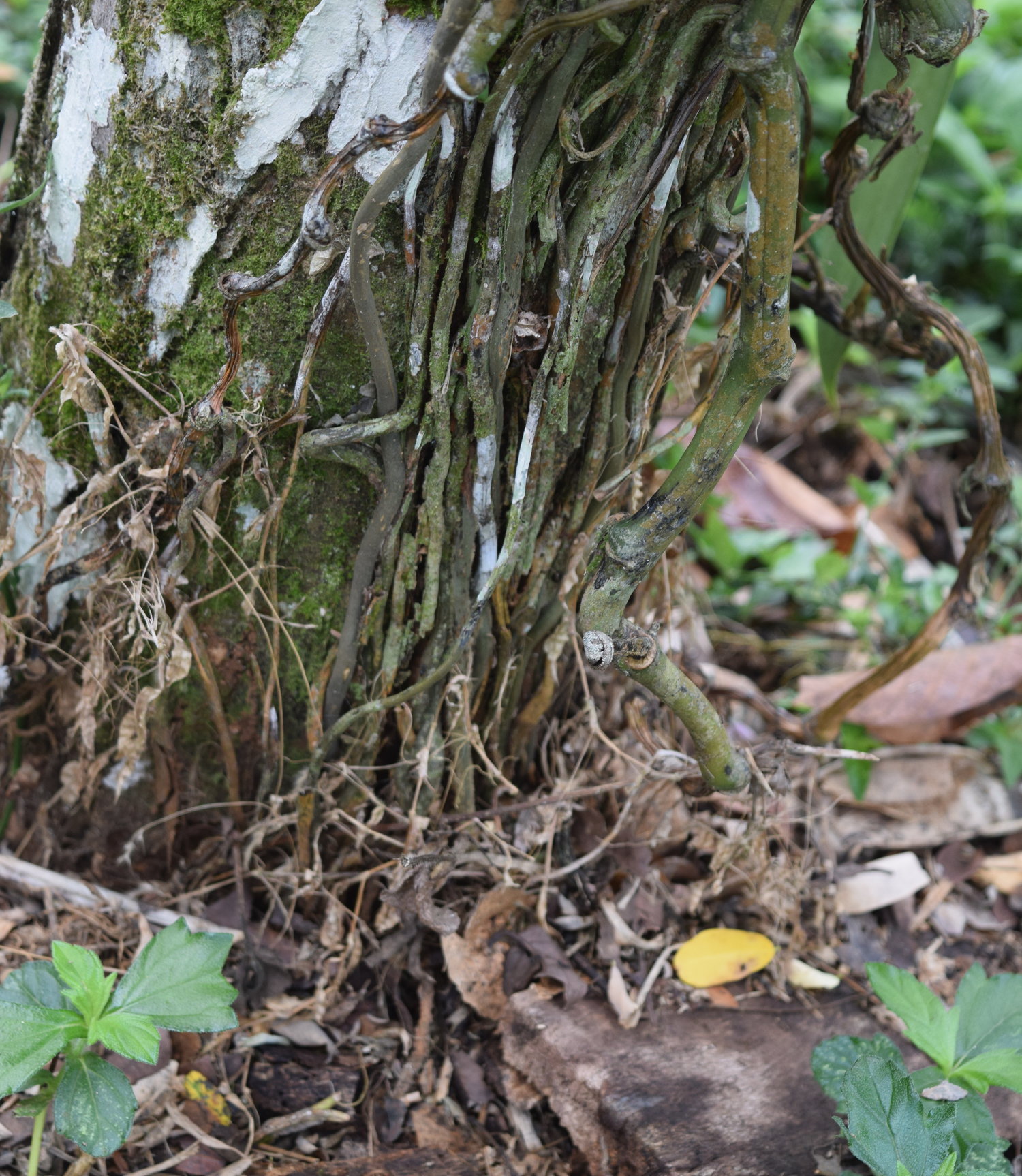
As any gardener knows, roots are the most important thing for a plant. Get a good big root ball, and you will have a healthy plant. We focus on the soil to ensure we get lots of roots able to absorb the maximum amount of nutrients. We don’t overwater when young so the roots don’t stop growing, but penetrate deep into the earth.
Growing sweetcorn, maize, is good for the soil, for the roots penetrate deep into the ground. When you harvest, you just cut it down and let the roots improve the soil.
With orchids, roots are even more important. You see them with masses of aerial roots, and these are vital when you are seeking scarce nutrition.
And of course, vanilla is an orchid, a type of Vanda, which just keeps on growing until it is too far away from its roots. At first you believe the important roots are the ones you can see… after all the vanilla has masses, clinging to the tree.
But this is not the case. These roots are indeed holding it fast to the tree and they go upwards at 45 degrees to encourage water collection. They are coated with a thick white skin, velamen. This is a specialized skin that absorbs water and nutrients, from the air and condensation and rain.
These are not the only roots.
Last year we switched from pots to putting cuttings straight into the ground, as the nursery was overwhelmed when we needed 10,000 plants. This was not effective, as the cuttings decide to shoot at wildly different times, from immediately to 6 months or even more. The result is a few gardens with very different stages of orchids which just looks wrong! It also effectively costs us as much as half a year before production. So we have gone back to pots. This means we plant out the ones that are ready. I told Agung Jaya who looks after the nursery to not plant them out till there were three leaves, to ensure no dying.
I go to examine the new plants in Garden 15, and find that many have no leaves at all, just starting! Agung explained to me that if they wait that long, the cuttings have developed great root systems that are damaged in planting out, which shocks the plant, kills it or stunts it.
We have to plant out when the roots say it is time, not the shoot. The little things that you learn as you go along, which should be obvious.
When we first started, Gardens 1,2 and 3 used up waste car tyres as barriers. Each vanilla orchid was planted inside a tyre, along with its shade tree and compost. The results were variable, and we realized the tyres kept the compost too moist, to say nothing of leaching chemicals. So, for Garden 4 we tried something different and made a raised bed using second hand clay roof tiles. Gardens 5 and 6, we built cages from chicken wire around the shade trees, a metre in diameter, and filled these with compost. The compost being the cocopeat. All three did well at first, before 5 started to lag behind. We decided the problem was that we planted underneath shade trees, the landowner growing a crop of wood. While fine for the first 6 months, there came a time when there was not enough sunshine.
At first, Garden 6 charged ahead. I began to think that this was actually because it was a wider garden, now I am convinced. Vanilla orchids need far more light than we first assumed. After another 6 months, Garden 4 took off, creating a wall of vanilla, to the extent that all new gardens became raised beds, and now we have converted Gardens 1, 2 and 3 to Raised Bed.
Why? Well, traditionally vanilla is planted directly into the ground, where it suffers badly from water-logging and root rot. With our compost, in the Caged Tree there is lots of compost immediately available, close by. The vanilla starts strongly. With the Raised Bed system, the compost is not so deep but there is much more of it. The vanilla roots head off. And don’t stop. They can go for 10m through the soft, easy compost, and they do, creating a mat of roots, an enormous root ball in the compost. We feed them by topping up the compost.
This is absolutely key to delivering the quantities of vanilla we want, without stressing the orchid. Stress kills orchids. You stress them by giving them too much fertilizer, especially chemical fertilizer, which kills the roots. Yes, roots again. Get a good big mass of roots, and you don’t have to worry about stressing your orchid.
Except we do, to make them flower, but that’s another story and temporary.
I bet you thought growing vanilla on a plantation was simple! Ah, well, back to the hammock to contemplate the growth. We get a new leaf every week!
REX SUMNER
Chairman Royal Spice Gardens
Royal Spice Gardens is an Indonesian Foreign Investment Company, in Indonesia known as a Perusahaan Modal Asing (PMA).
NIB Licence number 0220100502286. NPWP: 94.830.504.0- 905.000.
PT Royal Spice Gardens Indonesia, Jl. Prof. Dr. Ida Bagus Mantra, Jl. Pantai Saba No. 999 x No. Perempatan, Saba, Blahbatuh, Gianyar, Bali 80581 Indonesia
Website by Simia Solutions / Cre8 Design Studio
Powered by Pak Kriss’s Compliance Framework.
Even in uncertain times, credible, stable & realistic opportunities are available for the astute investor.
Get the edge by obtaining clear, concise and rapid information. Fill out the form to receive our latest prospectus!